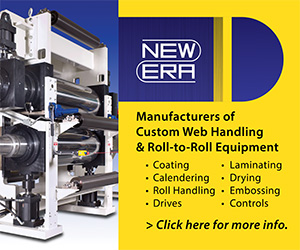Some Thoughts on the Pressure-Sensitive Industry
- Published: November 26, 2018, By Christine Pietryla Wetzler
I was part of the pressure sensitive adhesive industry for over 20 years. My earlier roles within the company related to business development and marketing. We had a well-established adhesive business when I joined the team, so I was uncertain as to what my true role would be and what type of industry I was entering. As I look back on it now, I am so glad I made the job change and found the world of sticky business!
Over my time in the industry, much has changed but much has remained the same. One key characteristic of the industry is its innovative and entrepreneurial spirit. People approach problems with the thought that there is a way to resolve them rather than that they represent impossible challenges. There is an underlying passion for success and helping the customer that drives the leaders to be collaborative and open to ideas. This is the spirit that must be encouraged as new team members join the ranks of the experienced.
Keeping the customer at the forefront is a crucial success factor. If an organization buys into the hype of “being on top,” like many sports teams, they begin to lose their way. It is imperative to remember success is built on continuing to delight the customer and that the customer always has a choice.
So, what has changed?
Technology has, of course, continued to drive the industry. This starts at the end-use application and flows back to adhesives and their raw materials.
When I joined the adhesives team so 20+ years ago, I was told not to bother learning much about our solvent-based adhesives portfolio as it would be phased out due to the environmental concerns relating to the use of solvent and the availability of alternative technologies both existing and emerging.
Today the sale of solvent-based adhesives continues to be strong and they are a vital part of many constructions. Why? Because they fit the demands of applications better than those alternatives. When you need excellent long-term aging, heat and solvent resistance, and balanced performance they offer a cost-effective solution.
Suppliers continue to expand their offerings creating better and better products with added benefits such as vibration damping and anti-fogging, extending the value beyond just providing a strong bond. The other technologies have also benefited from innovation. New hydrogenated tackifiers have extended the use of hot melt pressure sensitive adhesives to applications where UV stability is needed like clear on clear labels. Water-based acrylics have been developed that have better water resistance and higher shear holding power allowing them to be used on beverage labeling and tapes. All these innovations are driven by end-user needs. Namely, adhesives that provide cost-effective ways to provide adhesion and protection as the demands on the end uses become more stringent.
Computers run faster creating higher heat and vibrations, paint surfaces on cars are now lower surface energy so they repel dirt but then also resist adhesion, the use of vinyl for decorative surfaces continues to grow; all these have spurred the development and expanded use of pressure sensitive adhesives. Moreover, there is so much more that can be done.
As many in the industry continue to point out, any place where fasteners like nails, rivets
So where is the future and how does the industry continue to grow? It is not really that complicated. As I said in my opening paragraph, it is keeping abreast of what the customer needs to be successful.
Tracking end use trends is a place to start but also the open dialog with the immediate customer is imperative. Some years ago, adhesive suppliers started working on alternative technology to solvent-based acrylics, namely 100 percent solids radiation curable products.
Why? They saw a need to have an alternative that was more environmentally friendly to coat and also provided the benefit of coating faster. With the reliable infrastructure of available solvent-based coating equipment, this technology was slow to be adopted. Over the last several years interest has grown. Many coaters have faced challenges as they expand their operations; local municipalities are loath to approve further solvent based storage. And the high cost of equipment leaves the coater considering his options more closely.
Moreover, so now UV cured adhesives are slowly commercializing spurring further development by the suppliers. Will they entirely replace solvent-based adhesives? I personally do not see that happening as there are a variety of applications where they offer tremendous advantages which will be difficult to duplicate with alternatives. These include their high optical clarity, excellent
One area which the industry has not totally embraced is the emerging need for more environmentally friendly adhesive-based products.
The labeling industry is furthest along with recycle-friendly labels and some compostable products already available. For tapes and graphics, there are significant challenges. Most of the end use application demand high performance and stability so how do you create a product that degrades or decomposes when the product nears the end of its life? Can the industry find alternatives based on biotechnology to replace petroleum-based products? There are some of these raw materials already available, but the cost differential is still too great to spur widespread use. This is always a dilemma when new technologies that are emerging; cost points when use is small hinders widespread use, but widespread use is needed to get to scale for cost reduction.
Another area that is the “holy grail” for adhesive development is the concept of smart adhesives. A smart adhesive can be defined as one that sticks when we want it to and doesn’t when we don’t want it to or changes performance profile when triggered or activated. There are many areas where developing products like this would be of benefit. Think of printing packaging labels using a conventional printer and being able to activate the adhesive so the label sticks immediately thereafter.
Such products are already available on a limited basis today. An approach like this might improve recycling of parts. For instance, if we could trigger the release of a foil tape on a heating duct when being replaced it would be easier to reuse the aluminum in the duct. Another type of smart adhesive might be one that has some pressure sensitive properties allowing for its initial placement then becomes structural with shear adhesion many times that of current pressure sensitives. There are many construction applications where products like this would be of interest.
Medical applications are also an area where the use of pressure sensitive adhesives will continue to grow. A transdermal patch is an excellent vehicle to provide a consistent, reliable way to deliver needed drugs to a patient.
As the elderly population continues to grow and care shifts to home and institutional environments their use will expand as a cost-effective drug delivery method. Adhesive suppliers have also begun to consider the skin’s unique properties as a surface for adhesion and have targeted development of a whole range of new products. Growth will continue to focus on providing good adhesion but minimizing the damage to
So, as I move forward to explore new challenges and enjoy the benefits of retirement, I leave behind an industry that faces both challenges and opportunities. Those that will succeed will focus on the customer, encourage solid teamwork and collaboration, be open to new ideas and have an innovative spirit. And, of course, be tenacious and keep STICKING WITH IT.
So, I wish you, my readers, a fond farewell and leave you with my best wishes for success in the future. I thank you and PFFC magazine for the opportunity to share my thoughts and knowledge and hope I have helped you gain some insight into this complex industry
About the Author
 Ingrid Brase is a technical market strategist recognized for her ability to translate technical needs into business solutions. Her understanding of pressure-sensitive adhesives and their use is complemented by her strengths in strategic marketing, project management, new product development, and key account management. She is available for consulting or contact assignments in these areas. Ingrid’s expertise is a result of more than 20 years of experience in the p-s adhesives business. She was most recently the market segment director for Henkel Corp., rising to that position after various assignments in the p-s business unit. She began her career as a research scientist then progressed to market-focused roles. Ingrid earned her MBA at Rider Univ. and holds a BS in chemistry from SUNY/Oneonta. She has served on the board of directors for TLMI and AIMCAL in addition to chairing technical teams for both trade associations. Ingrid is a well-known speaker and author on topics related to adhesive use.
Ingrid Brase is a technical market strategist recognized for her ability to translate technical needs into business solutions. Her understanding of pressure-sensitive adhesives and their use is complemented by her strengths in strategic marketing, project management, new product development, and key account management. She is available for consulting or contact assignments in these areas. Ingrid’s expertise is a result of more than 20 years of experience in the p-s adhesives business. She was most recently the market segment director for Henkel Corp., rising to that position after various assignments in the p-s business unit. She began her career as a research scientist then progressed to market-focused roles. Ingrid earned her MBA at Rider Univ. and holds a BS in chemistry from SUNY/Oneonta. She has served on the board of directors for TLMI and AIMCAL in addition to chairing technical teams for both trade associations. Ingrid is a well-known speaker and author on topics related to adhesive use.







